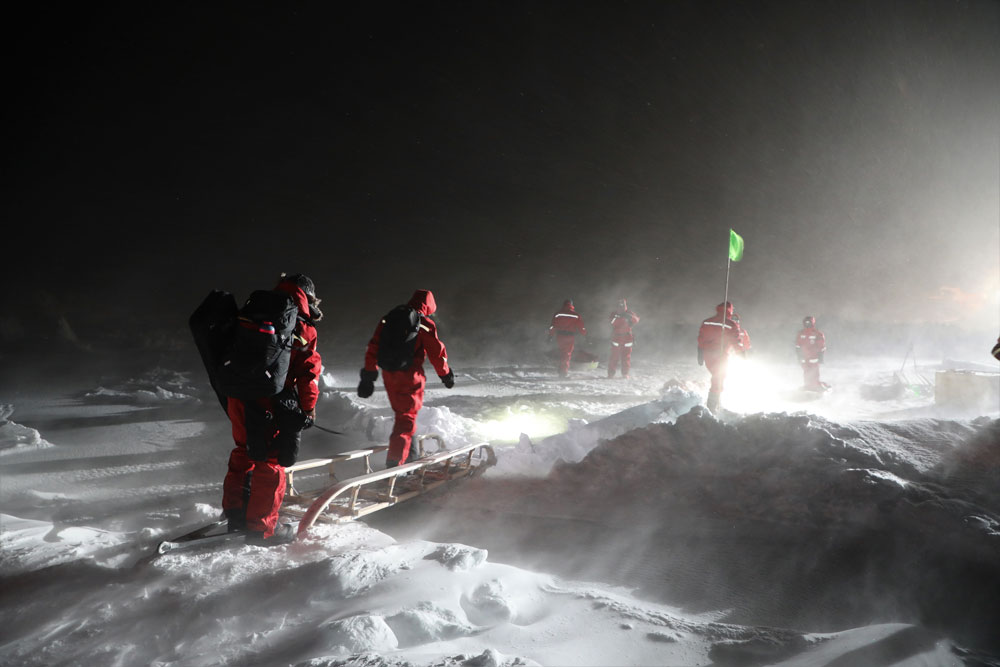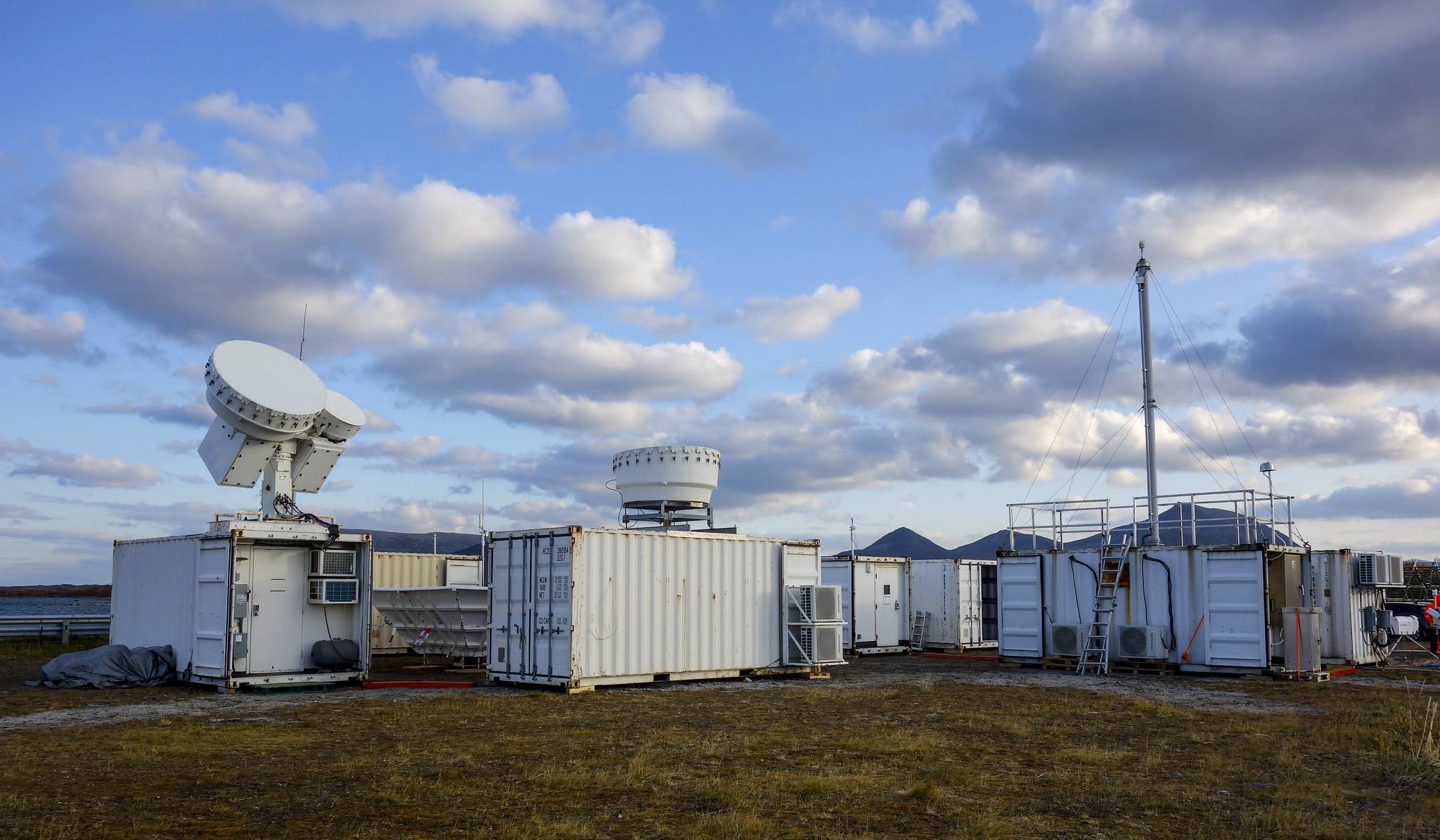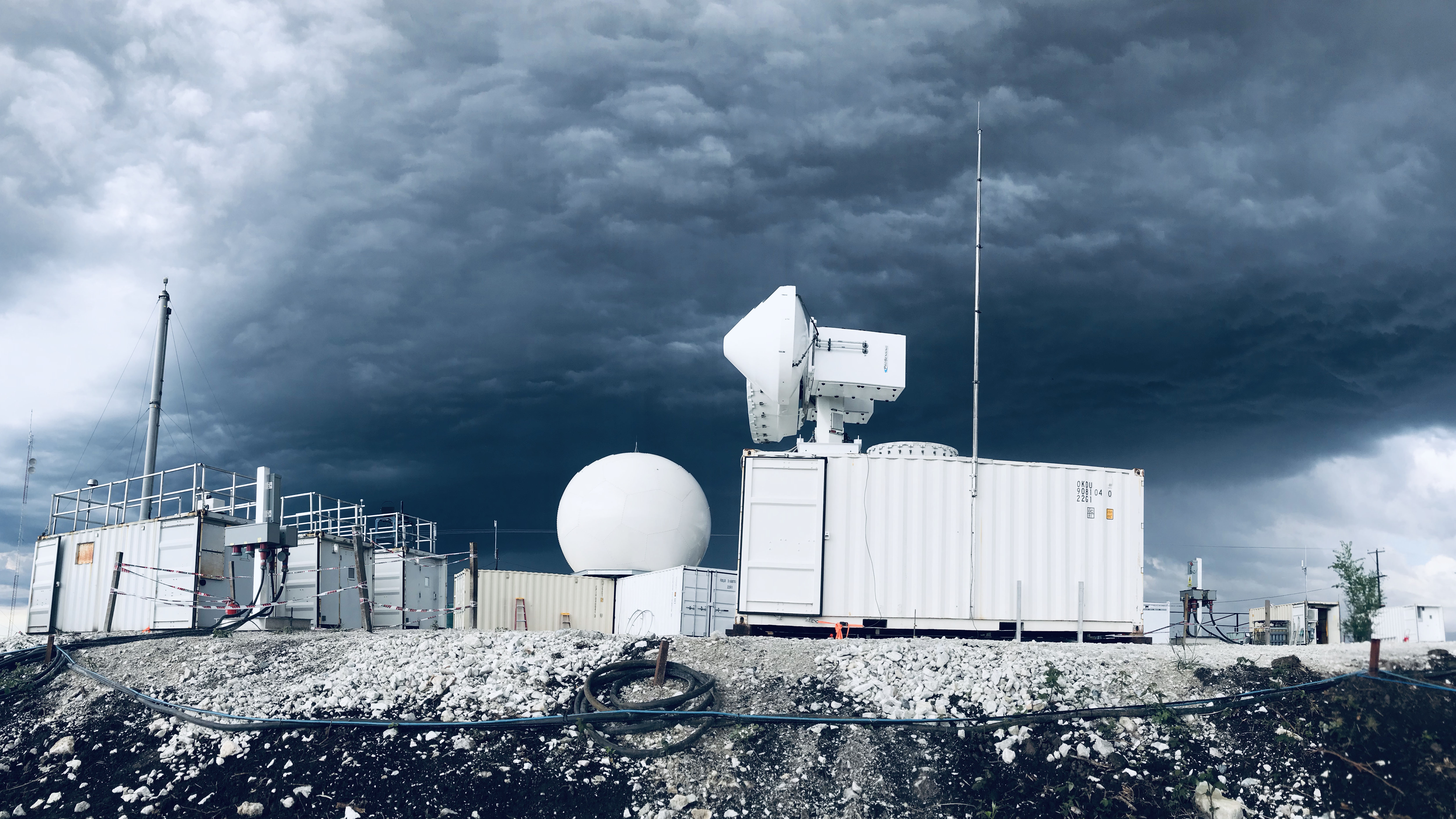2021 AGU Presentations Featuring ARM Data
Published: 20 December 2021
Editor’s note (December 20, 2021): Registered in-person and virtual attendees of the 2021 American Geophysical Union (AGU) Fall Meeting can log in to the meeting platform to view posters and recorded presentations until February 28.
 The 2021 American Geophysical Union (AGU) Fall Meeting offers a hybrid (in-person/virtual) format that allows attendees the chance to attend remotely if they are unable to travel to New Orleans, Louisiana. Virtual-only town halls are scheduled from December 6 to 9, and hybrid sessions are December 13 to 17.
The 2021 American Geophysical Union (AGU) Fall Meeting offers a hybrid (in-person/virtual) format that allows attendees the chance to attend remotely if they are unable to travel to New Orleans, Louisiana. Virtual-only town halls are scheduled from December 6 to 9, and hybrid sessions are December 13 to 17.
With content spread out over two weeks to accommodate participants in person and those attending virtually, it might feel overwhelming to plan your AGU schedule. We make it easy for you to find ARM-relevant science during the meeting.
Below is a list of ARM-related AGU meeting highlights (all times Central). Information is subject to change; please check the AGU Fall Meeting website for the most up-to-date information. Follow us on Twitter (@armnewsteam) and Facebook (@arm.gov) for a real-time guide to relevant activities using the hashtags #ARMAGU and #AGU21.
Go here to find more ARM-related presentations and posters, as well as sessions, talks, and posters related to Atmospheric System Research (ASR).
Add your presentation here to be featured on the ARM or ASR presentation web pages.
ARM is also hosting a virtual AGU booth, where you can get the full ARM AGU schedule, view facility materials, and meet with ARM representatives. Be sure to check out our booth under the Exhibitors tab in the AGU meeting platform. (See ARM’s exhibitor listing for more information.)
AGU has prepared an overview of the hybrid meeting experience. Go to the AGU Fall Meeting website to learn more about how the meeting will be structured.
ARM Flash Talks
Listen to ARM staff and users speak about a variety of topics, including recent field campaigns and upcoming ARM activities, in this series of flash talk videos.
ARM Town Halls
These 60-minute events are open to all meeting attendees (those attending virtually as well as those attending in person) and are best for collecting feedback or raising awareness for individuals from government agencies, academic programs, special projects, and other focused interest groups via a presentation, roundtable, or panel discussion. Check out these town halls related to ARM, DOE, and relevant interagency work.
Click Below to View:
Invited Presentations
Please note: On average, each presentation is scheduled to run five minutes, so the full session times are listed below for planning purposes. AGU’s in-person sessions will be at the Ernest N. Morial Convention Center.
- A12B-01: A Review of Global Monitoring and Data Assimilation of Aerosol Vertical Structure: Past, Present, and Future. Jeffrey S. Reid, U.S. Naval Research Laboratory. Oral.
Monday, December 13, 9:45 to 11 a.m., Convention Center – Room 275–277 (also virtual)
- A24G-06: Understanding DOE’s Earth and Environmental Systems Sciences Funding Opportunity Announcement Process. Shaima Nasiri, DOE Atmospheric System Research Program Manager. Oral.
Tuesday, December 14, 2:30 to 3:45 p.m., Convention Center – Room 275–277 (also virtual)
- C25B-0828: Research Infrastructure in the Arctic and New Initiatives for High Arctic Research Centers. Mark Ivey, Sandia National Laboratories. Poster.
Tuesday, December 14, 4 to 6 p.m., Convention Center – Poster Hall, D–F (also virtual)
Related ARM news coverage:- Sandia-Operated Arctic Measurement Facility Moves; Research to Continue (November 2021)
- ARM Mobile Facility Nears End of Deployment at Oliktok Point, Alaska (originally published in May 2021; updated in August 2021)
- A33F-01: Emerging Approaches to Assessing Aerosol-Cloud Interactions in Warm Marine Boundary Layer Clouds. Graham Feingold, NOAA. Oral.
Wednesday, December 15, 12:45 to 2 p.m., Virtual
- A35M-1838: Ensemble Based LES Simulations of Mesoscale Convective Systems. Andreas F. Prein, NCAR. Poster.
Wednesday, December 15, 4 to 6 p.m., Convention Center – Poster Hall, D–F (also virtual)
- A41A-01: Investigating the Processes Driving Day-to-Day and Seasonal Variability of Ice-Nucleating Particles in Marine Air. Susannah M. Burrows, Pacific Northwest National Laboratory. Oral.
Thursday, December 16, 8 to 9:15 a.m., Convention Center – Room 286–287 (also virtual)
Related ARM news coverage:- UEC Profile: Susannah Burrows Pays It Forward (ARM User Executive Committee feature, May 2021)
- Good Data, Good Awards (DOE Early Career Research Program award winners, July 2018)
- IN43A-06: Development of Data Standards for Unique Unmanned Aircraft Payloads. Jack Steward Elston, Black Swift Technologies. Oral.
Thursday, December 16, 12:45 to 2 p.m., Convention Center – Room 288–290 (also virtual)
- A44H-01: Impact of Aerosols on Shallow and Deep Convective Clouds: Some New Insight From Recent Studies. Zhanqing Li, University of Maryland, College Park. eLightning.
Thursday, December 16, 2:30 to 3:45 p.m., Convention Center – eLightning Theater VII (also virtual)
- A53D-02: Biomass Burning Aerosols in Most Climate Models Are Too Absorbing. Xiaohong Liu, Texas A&M University. Oral.
Friday, December 17, 12:45 to 2 p.m., Convention Center – Room 278–279 (also virtual)
- A54C-01: Supporting the Mission of the ARM User Facility, to Advance Atmospheric Science and Model Development, Through Collaboration With other Measurement Programs and Individual Investigators. Jim Mather, ARM Technical Director. Oral.
Friday, December 17, 2:30 to 3:45 p.m., Convention Center – Room 286–287 (also virtual)
Featured Field Campaign Presentations
Multidisciplinary Drifting Observatory for the Study of Arctic Climate (MOSAiC)

The massive MOSAiC expedition set out to document the atmosphere, sea ice, ocean, biogeochemistry, and ecosystem in the central Arctic. More than 400 field participants and 60 institutions from 20 countries were active in the German-led expedition from September 2019 to October 2020. MOSAiC’s central observatory was the icebreaker R/V Polarstern, which froze into and then drifted with the arctic sea ice for most of the year. ARM provided the most atmospheric instruments—more than 50—to the expedition.
Early during AGU week, there will be a presentation on uncrewed aerial system flights during MOSAiC:
- ORAL PRESENTATION—C22B-03: Uncrewed Aircraft Measurements of Surface Albedo and Melt Pond Fraction in the High Arctic During the Melting Season as Part of the MOSAiC Expedition. Radiance Calmer, University of Colorado, Boulder.
Tuesday, December 14, 9:45 to 11 a.m., Convention Center – Room 265–266 (also virtual)
Matthew Shupe, a DOE-funded principal investigator and a co-coordinator of the MOSAiC expedition, will be the primary convener of the following MOSAiC- and Arctic-themed AGU sessions:
- eLIGHTNING SESSION—C52C: Coupled-System Processes of the Central Arctic Atmosphere-Sea-Ice-Ocean System: Harnessing Field Observations and Advancing Models III eLightning
Friday, December 17, 9:45 to 11 a.m., Convention Center – eLightning Theater I (also virtual)
Reported ARM/DOE MOSAiC presentations:- C52C-08: Classification of Cloud Microphysical Properties as a Function of Sea Ice Concentration Conditions During MOSAiC. Pablo Saavedra Garfias, University of Leipzig.
- C52C-10: Quantifying Atmospheric Boundary Layer, Low-Level Jet, and Temperature Inversion Characteristics in the Central Arctic During the MOSAiC Expedition Using sUAS and Radiosonde Profiles. Gina Jozef, University of Colorado, Boulder.
- ORAL SESSION—C53B: Coupled-System Processes of the Central Arctic Atmosphere-Sea-Ice Ocean System: Harnessing Field Observations and Advancing Models I Oral
Friday, December 17, 12:45 to 2 p.m., Convention Center – Room 217–219 (also virtual)
Reported ARM/DOE MOSAiC presentations:- C53B-03: Annual Variability of Particle Size, Cloud Condensation Nuclei, and Particle Hygroscopicity in the Central Arctic. Xianda Gong, Washington University in St. Louis.
- C53B-04: The Seasonal Contrast of Aerosols that Can Seed Ice Formation in Central Arctic Clouds. Jessie Creamean, Colorado State University.
- C53B-08: Atmospheric Structure and Processes Associated With Significant, Multi-Disciplinary, Environmental Transitions in the Central Arctic. Ola P.G. Persson, Cooperative Institute for Research in Environmental Sciences.
- ORAL SESSION—C54B: Coupled-System Processes of the Central Arctic Atmosphere-Sea-Ice Ocean System: Harnessing Field Observations and Advancing Models II Oral
Friday, December 17, 2:30 to 3:45 p.m., Convention Center – Room 217–219 (also virtual)
- POSTER SESSION—C55C: Coupled-System Processes of the Central Arctic Atmosphere-Sea-Ice-Ocean System: Harnessing Field Observations and Advancing Models IV Poster
Friday, December 17, 4 to 6 p.m., Convention Center – Poster Hall, D–F (also virtual)
Reported ARM/DOE MOSAiC presentations:- C55C-0603: Driving Mechanisms for the Onset of the Summer Melt Season at MOSAiC. Christopher Cox, NOAA.
- C55C-0604: Cloud-Atmosphere Impacts on the Central Arctic Surface Energy Budget. Matthew Shupe, Cooperative Institute for Research in Environmental Sciences.
Cold-Air Outbreaks in the Marine Boundary Layer Experiment (COMBLE)

COMBLE, which ran from December 2019 through May 2020, examined important but little-understood atmospheric processes by studying cold-air outbreaks in the marine boundary layer in the Norwegian Sea. As part of COMBLE, ARM deployed a mobile facility on the Norwegian island of Andøya and a second instrument site at nearby Bear Island, Norway.
Involving researchers from more than 15 institutions in the United States and Europe, COMBLE provided rich data that aim to close gaps in what scientists know about the properties of clouds formed by cold-air outbreaks and their processes within affected boundary layers.
COMBLE Principal Investigator Bart Geerts is a convener of the following two sessions:
- ORAL SESSION—A41A: Aerosol, Cloud, Precipitation, and Radiation Studies Over High-Latitude Oceans I Oral
Primary Convener: Greg McFarquhar, Cooperative Institute for Severe and High-Impact Weather Research and Operations/University of Oklahoma.
Thursday, December 16, 8 to 9:15 a.m., Convention Center – Room 286–287 (also virtual)
Reported COMBLE presentations:- A41A-02: Ice Nucleating Particle Sources and Transports During Arctic Cold Air Outbreaks. Benjamin Swanson, Colorado State University.
- A41A-08: Cloud and Environmental Conditions of the Late-March Marine Cold-Air Outbreak During COMBLE: An Observational Case Study. Christian P. Lackner, University of Wyoming.
- POSTER SESSION—A45B: Aerosol, Cloud, Precipitation, and Radiation Studies Over High-Latitude Oceans II Poster
Primary Convener: Greg McFarquhar, Cooperative Institute for Severe and High-Impact Weather Research and Operations/University of Oklahoma.
Thursday, December 16, 4 to 6 p.m., Convention Center – Poster Hall, D–F (also virtual)
Reported COMBLE presentations:- A45B-1829: Cloud Morphology Evolution in Arctic Cold-Air Outbreak: A COMBLE Case Study. Peng Wu, Pacific Northwest National Laboratory.
- A45B-1830: The Boundary Layer and Cloud Field Associated With Marine Cold Air Outbreaks (MCAOs) in the COMBLE Observations and the SCREAM DYAMOND2 Simulation. Xue Zheng, Lawrence Livermore National Laboratory.
- A45B-1831: The Dynamics and Microphysics of High-Latitude Clouds During the COMBLE Field Experiment. Zackary Mages, American Geophysical Union.
- A45B-1832: Dependence of Retrieved Cloud Properties on Environmental Conditions in Cold Air Outbreaks Over the North Atlantic: Results From COMBLE. Zeqian (Hazel) Xia, University of Oklahoma.
Another COMBLE poster will be presented during AGU:
- POSTER—GC55A-0405: Study of a Polar Low in Norwegian Sea Using COMBLE Observations and Numerical Modeling. Yonggang Wang, State University of New York at Oswego.
Friday, December 17, 4 to 6 p.m., Convention Center – Poster Hall, D–F (also virtual)
Cloud, Aerosol, and Complex Terrain Interactions (CACTI)

From October 2018 through April 2019, CACTI collected ground and aerial data to explore the life cycles of convective clouds in Argentina’s Sierras de Córdoba mountain range. This area is said to spawn the biggest thunderstorms in the world. The campaign featured the first deployment of the second-generation C-Band Scanning ARM Precipitation Radar, which delivers slice-like flat images of the atmosphere. CACTI ran concurrently with Remote sensing of Electrification, Lightning, And Mesoscale/microscale Processes with Adaptive Ground Observations (RELAMPAGO), a campaign funded largely by the National Science Foundation.
With 80 days of deep convection observed, CACTI represents a new wealth of measurements on cloud dynamics and microphysics, ambient thermodynamic and kinematic and surface conditions, and properties of aerosols. The next scenario of focus for the Large-Eddy Simulation (LES) ARM Symbiotic Simulation and Observation (LASSO) activity will be deep convection during CACTI.
- POSTER—B15G-1501: Comparisons of Planetary Boundary Layer Height Derived Using Lidar Measurements With Sounding Data. Damao Zhang, Pacific Northwest National Laboratory.
Monday, December 13, 4 to 6 p.m., Convention Center – Poster Hall, D–F (also virtual)
- ORAL PRESENTATION—A22G-06: Environments Supporting Deep Convection Initiation During the CACTI Campaign. James Marquis, Pacific Northwest National Laboratory.
Tuesday, December 14, 9:45 to 11 a.m., Convention Center – Room 283–285 (also virtual)
- ORAL PRESENTATION—A23H-04: Indications of a Decrease in the Depth of Deep Convective Cores With Increasing Aerosol Concentration During the CACTI Campaign. Peter Veals, University of Utah.
Tuesday, December 14, 12:45 to 2 p.m., Virtual
- POSTER—A25B-1665: Assimilation of Radar and Radiosonde Observations Into a Large Eddy Simulation of a Deep Convective Storm. Sheng Lun Tai, Pacific Northwest National Laboratory.
Tuesday, December 14, 4 to 6 p.m., Convention Center – Poster Hall, D–F (also virtual)
- ORAL PRESENTATION—A25T-02: Environmental Controls on Deep Convection Initiation and Growth in the Complex Terrain of Central Argentina During CACTI. Zhe Feng, Pacific Northwest National Laboratory.
Tuesday, December 14, 4 to 5:15 p.m., Virtual
- POSTER—A25D-1707: Sensitivity of Deep Convection Evolution to Environmental Conditions in a Large Model Ensemble and Observations. Katelyn A. Barber, Pacific Northwest National Laboratory.
Tuesday, December 14, 4 to 6 p.m., Convention Center – Poster Hall, D–F (also virtual)
- POSTER—A35M-1841: The Benefit of LES Libraries for Advancing Boundary Layer and Cloud Research: The LASSO Activities for Shallow and Deep Convection. William Gustafson, Pacific Northwest National Laboratory.
Wednesday, December 15, 4 to 6 p.m., Convention Center – Poster Hall, D–F (also virtual)
- POSTER SESSION—A45Q: Observation and Model Studies of Cloud Properties and Associated Processes II Poster
Primary Convener: Chuanfeng Zhao, Beijing Normal University.
Thursday, December 16, 4 to 6 p.m., Convention Center – Poster Hall, D–F (also virtual)
Reported CACTI presentations:- A45Q-2076: Processes Affecting Drizzle Formation and Intensity in Continental Shallow Clouds. Paloma Borque, Pacific Northwest National Laboratory.
- A45Q-2090: Turbulent Supersaturation Fluctuations and Cloud Droplet Spectral Broadening Observed During HI-SCALE and CACTI. Yayun Qiao, University of Oklahoma.
Keep up with the Atmospheric Observer
Updates on ARM news, events, and opportunities delivered to your inbox
ARM User Profile
ARM welcomes users from all institutions and nations. A free ARM user account is needed to access ARM data.


















